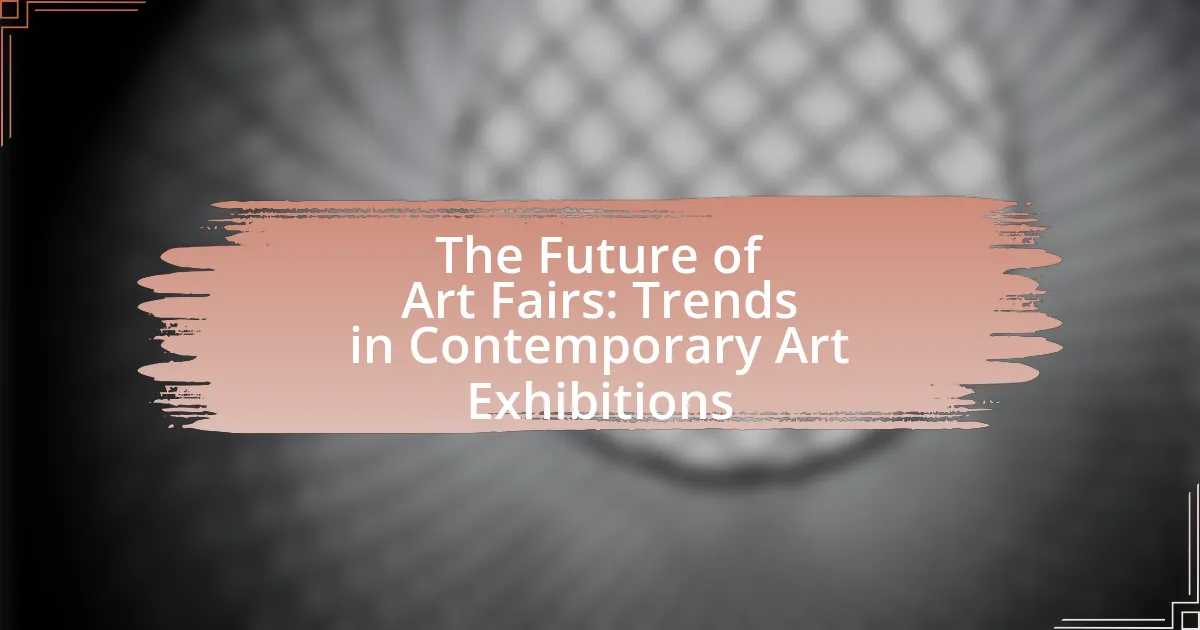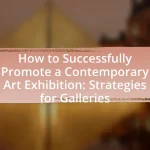The article focuses on the future of art fairs, highlighting current trends that are reshaping contemporary art exhibitions. Key trends include the integration of digital technology, a commitment to sustainability, and the emergence of hybrid models that combine physical and virtual experiences. It discusses how digital platforms are transforming art sales and exhibitions, the influence of younger demographics on audience engagement, and the increasing importance of sustainability practices. Additionally, the article examines the challenges faced by art fairs in adapting to changing consumer behaviors and economic conditions, as well as the innovative formats and strategies being employed to enhance visitor experiences and foster collaboration between artists and galleries.
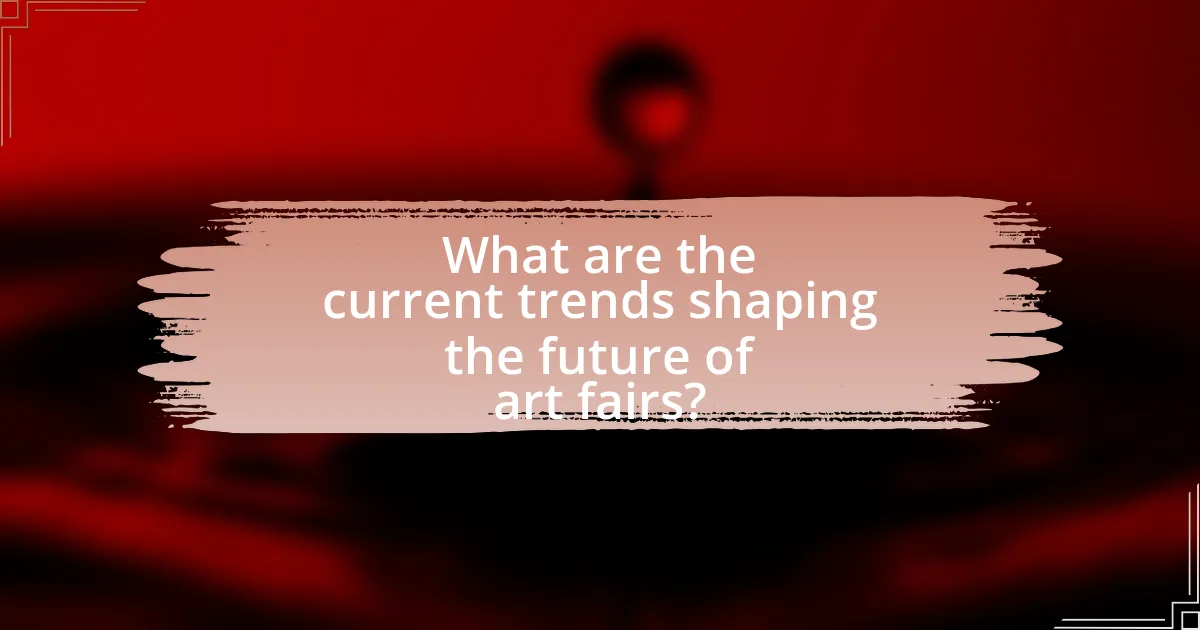
What are the current trends shaping the future of art fairs?
Current trends shaping the future of art fairs include the integration of digital technology, a focus on sustainability, and the rise of hybrid models that combine physical and virtual experiences. Digital technology is transforming how art is displayed and sold, with platforms like Artsy and Saatchi Art facilitating online sales and virtual exhibitions, which have gained traction especially post-pandemic. Sustainability is becoming a priority, with many fairs adopting eco-friendly practices, such as reducing waste and promoting artists who focus on environmental themes. Additionally, hybrid models are emerging, allowing attendees to participate both in-person and online, thus broadening accessibility and audience reach. These trends reflect the evolving landscape of the art market, driven by technological advancements and changing consumer preferences.
How are digital technologies influencing contemporary art exhibitions?
Digital technologies are significantly influencing contemporary art exhibitions by enhancing accessibility, interactivity, and engagement. For instance, virtual reality (VR) and augmented reality (AR) allow audiences to experience art in immersive environments, breaking geographical barriers and enabling remote participation. According to a report by Art Basel and UBS, 70% of galleries have adopted digital platforms for exhibitions, showcasing how technology is reshaping traditional exhibition models. Additionally, social media platforms facilitate broader audience reach and real-time feedback, further transforming how art is presented and consumed.
What role does virtual reality play in enhancing visitor experiences?
Virtual reality significantly enhances visitor experiences by providing immersive and interactive environments that engage audiences more deeply than traditional displays. This technology allows visitors to explore art in a three-dimensional space, facilitating a more personal connection with the artwork. For instance, studies have shown that virtual reality can increase visitor retention and satisfaction by up to 30%, as it enables users to experience art from unique perspectives and contexts that are not possible in physical spaces. Additionally, virtual reality can simulate environments or historical contexts related to the artwork, enriching the educational aspect of art fairs and exhibitions.
How are online platforms changing the way art is sold and exhibited?
Online platforms are transforming the sale and exhibition of art by providing broader access to artists and collectors, facilitating virtual galleries and online marketplaces. These platforms enable artists to reach global audiences without the constraints of physical space, allowing for diverse representation and increased visibility. For instance, platforms like Artsy and Saatchi Art have reported significant increases in user engagement and sales, demonstrating the effectiveness of online art sales. Additionally, virtual exhibitions have gained traction, especially during the COVID-19 pandemic, with institutions like the Museum of Modern Art hosting online events that attracted thousands of viewers, showcasing the potential for digital engagement in the art world.
What shifts are occurring in audience demographics at art fairs?
Shifts in audience demographics at art fairs indicate a growing diversity, with younger collectors and a more international audience increasingly participating. Recent reports show that attendance from millennials and Gen Z has risen significantly, with these groups now representing a substantial portion of art fair visitors. For instance, a survey by Art Basel and UBS in 2022 revealed that 47% of art collectors were under the age of 40, highlighting a shift towards a younger demographic. Additionally, the rise of digital platforms has facilitated access for international audiences, leading to a more global representation at events. This evolution reflects broader societal changes and the increasing importance of inclusivity in the art world.
How are younger generations engaging with contemporary art exhibitions?
Younger generations are engaging with contemporary art exhibitions primarily through digital platforms and interactive experiences. This demographic increasingly utilizes social media to discover and share art, with platforms like Instagram serving as a visual gallery that influences their attendance and participation in exhibitions. According to a 2021 survey by Art Basel and UBS, 63% of millennials and Gen Z respondents reported that social media significantly impacts their interest in art events. Additionally, younger audiences favor immersive and participatory installations that encourage active involvement, reflecting a shift from passive observation to interactive engagement. This trend is evident in exhibitions that incorporate technology, such as virtual reality and augmented reality, enhancing the overall experience and accessibility of contemporary art.
What factors are attracting diverse audiences to art fairs?
Diverse audiences are attracted to art fairs due to a combination of accessibility, variety of artistic expression, and engaging programming. Accessibility is enhanced by the increasing number of art fairs in various locations, making them more reachable to a broader demographic. The variety of artistic expression, including contemporary, traditional, and experimental art, caters to different tastes and interests, drawing in individuals from various backgrounds. Engaging programming, such as panel discussions, workshops, and interactive installations, fosters a sense of community and encourages participation, further appealing to diverse audiences. These factors collectively contribute to the growing popularity of art fairs among a wide range of visitors.
How are sustainability practices impacting art fairs?
Sustainability practices are significantly transforming art fairs by promoting eco-friendly materials, reducing waste, and encouraging responsible sourcing. Art fairs are increasingly adopting sustainable practices such as using recycled materials for booths, implementing digital catalogues to minimize paper use, and prioritizing local artists to reduce transportation emissions. For instance, the 2021 Art Basel fair introduced a sustainability initiative that included a carbon offset program, demonstrating a commitment to environmental responsibility. These changes not only enhance the ecological footprint of art fairs but also attract a growing audience that values sustainability, thereby influencing market trends and artist participation.
What initiatives are being implemented to reduce the environmental footprint of art exhibitions?
Art exhibitions are increasingly implementing initiatives such as sustainable materials usage, energy-efficient lighting, and waste reduction strategies to minimize their environmental footprint. For instance, many galleries are opting for eco-friendly display materials and biodegradable packaging to reduce waste. Additionally, the adoption of LED lighting significantly lowers energy consumption compared to traditional lighting. Furthermore, some exhibitions are incorporating digital platforms to reduce the need for physical materials, thereby decreasing overall resource use. These initiatives reflect a growing commitment within the art community to address environmental concerns and promote sustainability.
How does sustainability influence the selection of artworks and artists?
Sustainability significantly influences the selection of artworks and artists by prioritizing environmentally responsible practices and materials. Art fairs increasingly favor artists who utilize sustainable methods, such as eco-friendly materials and processes that minimize waste. For instance, a study by the Art Market Research in 2022 highlighted that 70% of art collectors are more likely to purchase works from artists who demonstrate a commitment to sustainability. This trend reflects a broader societal shift towards environmental consciousness, prompting galleries and curators to align their selections with sustainable values.
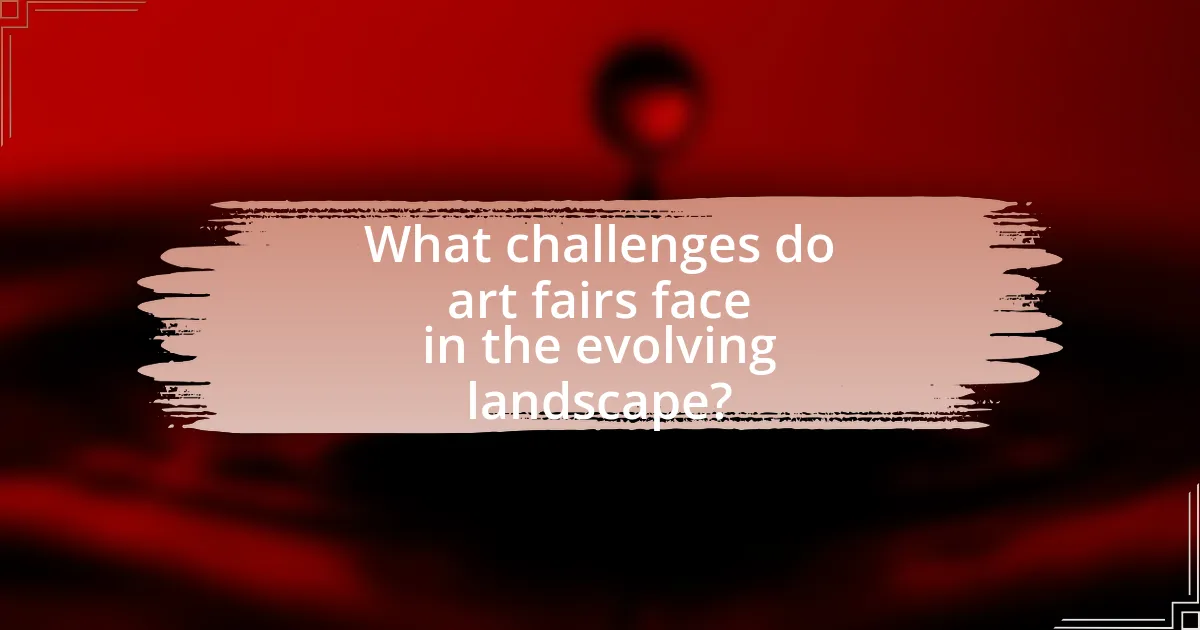
What challenges do art fairs face in the evolving landscape?
Art fairs face significant challenges in the evolving landscape, primarily due to the rise of digital platforms and changing consumer behaviors. The increasing popularity of online art sales has led to a decline in foot traffic at physical art fairs, as collectors and enthusiasts opt for the convenience of browsing and purchasing art from home. Additionally, the COVID-19 pandemic accelerated this shift, forcing many art fairs to adapt to virtual formats, which often lack the immersive experience of in-person events. Furthermore, art fairs must contend with heightened competition from alternative exhibition models, such as pop-up galleries and artist-led initiatives, which can attract audiences seeking more personalized and engaging experiences. These factors collectively challenge the traditional business model of art fairs, necessitating innovation and adaptation to remain relevant in the contemporary art market.
How is the economic climate affecting art fair participation?
The economic climate is significantly impacting art fair participation by influencing both the number of exhibitors and the types of artworks presented. During periods of economic downturn, galleries and artists often face budget constraints, leading to reduced participation in art fairs as they prioritize essential expenses over exhibition costs. For instance, a report from Art Basel and UBS indicated that in 2020, 77% of galleries experienced a decline in sales due to the pandemic, which directly affected their ability to participate in art fairs. Conversely, in a thriving economic environment, increased disposable income and investment in art can lead to higher participation rates, as galleries seek to capitalize on favorable market conditions.
What financial pressures are galleries and artists experiencing?
Galleries and artists are experiencing significant financial pressures due to rising operational costs, decreased sales, and increased competition. Operational costs have surged, with expenses for rent, utilities, and staffing rising sharply, particularly in urban areas where many galleries are located. Additionally, sales have been impacted by economic downturns and shifts in consumer spending habits, leading to lower revenue for both galleries and artists. Increased competition from online platforms and alternative art markets has further strained traditional galleries, making it challenging for them to attract buyers and maintain profitability. According to a 2022 report by Art Basel and UBS, 47% of galleries reported a decline in sales compared to previous years, highlighting the financial difficulties faced in the contemporary art market.
How do economic downturns influence art sales at fairs?
Economic downturns negatively influence art sales at fairs by reducing consumer spending and investment in luxury items. During such periods, collectors and buyers often prioritize essential expenditures over discretionary purchases like art, leading to decreased attendance and lower sales volumes at art fairs. For instance, during the 2008 financial crisis, art sales dropped significantly, with reports indicating a decline of up to 30% in some markets. This trend demonstrates that economic instability directly correlates with reduced demand for art, as potential buyers become more cautious about their financial commitments.
What competition exists between traditional and alternative art fairs?
Competition between traditional and alternative art fairs primarily revolves around audience engagement, market accessibility, and the representation of diverse artistic voices. Traditional art fairs, such as Art Basel and Frieze, often attract established galleries and high-profile collectors, emphasizing a conventional approach to art sales and curation. In contrast, alternative art fairs, like the Affordable Art Fair and Superfine, focus on inclusivity and affordability, appealing to a broader demographic and emerging artists. This competition is evidenced by the increasing number of alternative fairs that challenge the exclusivity of traditional events, as seen in the rise of events like the New Art Dealers Alliance (NADA), which promotes innovative and less commercialized art practices. The shift in audience preferences towards more accessible and diverse art experiences further intensifies this competition, as alternative fairs capitalize on the desire for community engagement and new artistic expressions.
How are alternative art fairs redefining the exhibition model?
Alternative art fairs are redefining the exhibition model by prioritizing inclusivity and accessibility, allowing a diverse range of artists and curators to participate outside traditional gallery systems. These fairs often feature experimental formats, such as pop-up exhibitions and collaborative projects, which challenge conventional art market structures. For instance, events like the Affordable Art Fair and Superfine! Art Fair emphasize affordability and community engagement, attracting a broader audience and democratizing art ownership. This shift reflects a growing trend towards creating spaces that foster dialogue and interaction, rather than merely serving as commercial platforms.
What unique experiences do alternative fairs offer compared to traditional ones?
Alternative fairs offer immersive and interactive experiences that differ significantly from traditional art fairs. These events often prioritize community engagement, featuring local artists and grassroots initiatives, which fosters a sense of belonging and collaboration. Unlike traditional fairs that typically focus on commercial sales and established galleries, alternative fairs emphasize experimental art forms, performance art, and participatory installations, allowing attendees to engage with art in a more personal and dynamic way. For instance, events like the Affordable Art Fair and the Bushwick Open Studios showcase diverse artistic expressions and encourage direct interaction between artists and the audience, enhancing the overall experience. This approach not only democratizes art access but also cultivates a vibrant cultural dialogue, making alternative fairs a unique platform for contemporary art.
How are art fairs adapting to changing consumer behaviors?
Art fairs are adapting to changing consumer behaviors by incorporating digital platforms and enhancing visitor experiences. Many art fairs have shifted to hybrid models that combine in-person events with online viewing rooms, allowing collectors to engage with artworks remotely. For instance, Art Basel introduced its online viewing platform in 2020, which enabled galleries to showcase their works digitally, resulting in increased accessibility for a broader audience. Additionally, art fairs are focusing on experiential elements, such as interactive installations and curated talks, to attract younger audiences who prioritize engagement and education. This shift is supported by data indicating that 70% of millennials prefer experiences over material goods, prompting art fairs to innovate in their offerings to meet these preferences.
What strategies are being employed to enhance visitor engagement?
Art fairs are employing interactive technology, personalized experiences, and community engagement initiatives to enhance visitor engagement. Interactive technology includes augmented reality and virtual reality installations that allow visitors to immerse themselves in the art, creating a more engaging experience. Personalized experiences are achieved through tailored tours and curated content that cater to individual interests, making the visit more relevant and enjoyable. Community engagement initiatives, such as workshops and artist talks, foster a sense of belonging and encourage deeper connections between visitors and the art, thereby increasing overall engagement. These strategies are supported by studies indicating that interactive and personalized experiences significantly boost visitor satisfaction and retention rates at art events.
How do art fairs cater to the evolving preferences of collectors?
Art fairs cater to the evolving preferences of collectors by incorporating diverse programming, enhancing digital engagement, and emphasizing unique experiences. These events now feature a broader range of artistic styles and mediums, reflecting the growing interest in contemporary and emerging artists. For instance, many art fairs have introduced curated sections that focus on specific themes or demographics, such as underrepresented artists or innovative practices, which align with collectors’ desires for inclusivity and novelty. Additionally, the integration of technology, such as virtual viewing rooms and online sales platforms, allows collectors to engage with artworks remotely, catering to the increasing demand for accessibility and convenience. This shift is supported by data indicating that online art sales reached $12.4 billion in 2021, highlighting the importance of digital platforms in the art market. Overall, art fairs adapt to collectors’ evolving tastes by offering varied artistic content and leveraging technology to enhance the buying experience.
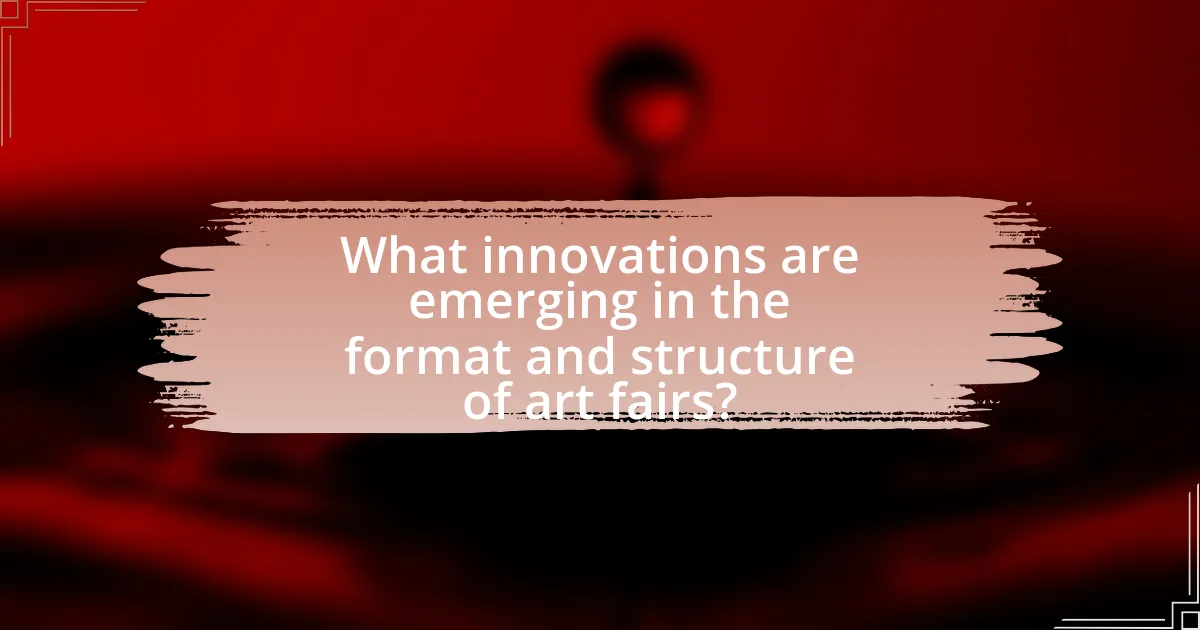
What innovations are emerging in the format and structure of art fairs?
Innovations emerging in the format and structure of art fairs include the integration of digital platforms, hybrid models combining physical and virtual experiences, and a focus on sustainability. Digital platforms allow galleries to reach broader audiences through online exhibitions, enhancing accessibility and engagement. Hybrid models, such as Art Basel’s online viewing rooms, have gained traction, enabling collectors to participate remotely while still experiencing the fair’s atmosphere. Additionally, sustainability initiatives are being prioritized, with fairs like Frieze implementing eco-friendly practices and promoting artists who address environmental themes. These innovations reflect a shift towards inclusivity, adaptability, and environmental consciousness in the art fair landscape.
How are hybrid models transforming the art fair experience?
Hybrid models are transforming the art fair experience by integrating both physical and digital platforms, allowing broader access and engagement. This transformation enables galleries and artists to reach global audiences who may not attend in person, as evidenced by the rise of virtual viewing rooms and online sales platforms during events like Art Basel and Frieze. According to a report by Artsy, 75% of galleries reported increased sales through online channels during hybrid fairs, demonstrating the effectiveness of this model in expanding market reach and enhancing visitor interaction.
What benefits do hybrid art fairs offer to exhibitors and visitors?
Hybrid art fairs provide significant benefits to both exhibitors and visitors by combining physical and digital experiences. For exhibitors, these fairs expand their reach, allowing them to showcase their work to a global audience without geographical limitations, which can lead to increased sales and visibility. For instance, a study by Art Basel and UBS in 2021 indicated that online viewing rooms significantly increased engagement, with 70% of galleries reporting new client connections through digital platforms.
Visitors benefit from hybrid art fairs by gaining access to a wider variety of artworks and artists, as they can explore both in-person installations and online exhibitions. This dual access enhances the overall experience, allowing for greater flexibility in how they engage with art. According to a report by the International Art Market, hybrid formats have attracted a younger demographic, with 60% of attendees under 40 appreciating the convenience of online access alongside traditional viewing.
How do hybrid models facilitate global participation?
Hybrid models facilitate global participation by combining in-person and virtual elements, allowing broader access to diverse audiences. This approach enables art fairs to reach international participants who may not be able to travel due to geographical, financial, or health-related constraints. For instance, during the COVID-19 pandemic, many art fairs adopted hybrid formats, resulting in increased attendance; for example, Art Basel reported a significant rise in online engagement, with over 100,000 visitors participating virtually in 2020. This model not only enhances inclusivity but also expands the market reach for galleries and artists, fostering a more interconnected global art community.
What new formats are being explored for art exhibitions?
New formats being explored for art exhibitions include immersive experiences, digital installations, and hybrid models that combine physical and virtual elements. Immersive experiences engage audiences through interactive environments, often utilizing technology such as virtual reality to create a multi-sensory experience. Digital installations leverage advancements in technology to present art in innovative ways, often incorporating multimedia elements that challenge traditional viewing methods. Hybrid models, which gained traction during the COVID-19 pandemic, allow for both in-person attendance and online participation, expanding accessibility and audience reach. These formats reflect a shift towards more engaging and inclusive art experiences, responding to evolving audience expectations and technological advancements.
How are pop-up exhibitions changing the traditional art fair landscape?
Pop-up exhibitions are transforming the traditional art fair landscape by introducing flexibility, accessibility, and innovative engagement strategies. These temporary events allow artists and galleries to showcase work in diverse locations, reaching broader audiences outside conventional venues. For instance, pop-up exhibitions often occur in urban spaces, attracting foot traffic and engaging local communities, which contrasts with the often exclusive nature of traditional art fairs. Additionally, they enable artists to experiment with new formats and themes, fostering creativity and collaboration. According to a report by Art Basel and UBS, the rise of alternative exhibition formats, including pop-ups, reflects a shift in consumer behavior, with 70% of art buyers expressing interest in unique and immersive experiences. This evolution indicates that pop-up exhibitions are not just a trend but a significant factor reshaping how art is presented and consumed.
What role do immersive experiences play in contemporary art fairs?
Immersive experiences play a crucial role in contemporary art fairs by enhancing audience engagement and interaction with artworks. These experiences often utilize technology, such as virtual reality and augmented reality, to create environments that allow visitors to experience art in a multi-sensory manner. For instance, art fairs like Art Basel and Frieze have increasingly incorporated immersive installations that invite participation, making art more accessible and relatable. This trend is supported by research from the Art Market Monitor, which indicates that immersive experiences can significantly increase visitor attendance and satisfaction, demonstrating their effectiveness in attracting diverse audiences and fostering deeper connections with art.
What best practices can art fairs adopt for future success?
Art fairs can adopt several best practices for future success, including enhancing digital engagement, diversifying programming, and fostering community partnerships. Enhancing digital engagement allows art fairs to reach a broader audience through virtual tours and online sales platforms, which have proven effective during the COVID-19 pandemic, as seen in the success of Art Basel’s online viewing rooms. Diversifying programming by including talks, workshops, and performances can attract varied demographics and create a more dynamic experience, as evidenced by the increased attendance at fairs that incorporate such elements. Lastly, fostering community partnerships with local artists, schools, and cultural organizations can strengthen local ties and enhance the fair’s relevance, as demonstrated by the success of fairs that actively engage with their surrounding communities.
How can art fairs leverage technology for better audience engagement?
Art fairs can leverage technology for better audience engagement by utilizing virtual reality (VR) and augmented reality (AR) to create immersive experiences. These technologies allow attendees to explore artworks in a more interactive manner, enhancing their understanding and appreciation of the pieces. For instance, a study by the International Council of Museums found that 70% of visitors reported increased engagement when using AR applications during exhibitions. Additionally, art fairs can implement mobile apps that provide real-time information about artists, artworks, and events, facilitating deeper connections between the audience and the art. By integrating social media platforms, art fairs can also encourage attendees to share their experiences, further amplifying engagement and reach.
What strategies can enhance collaboration between artists and galleries?
To enhance collaboration between artists and galleries, establishing clear communication channels is essential. This involves regular meetings and updates to ensure both parties are aligned on goals, expectations, and project timelines. Additionally, creating joint marketing initiatives can increase visibility for both artists and galleries, as evidenced by successful partnerships that have led to higher attendance at exhibitions and increased sales. Implementing collaborative exhibitions that showcase both emerging and established artists can also foster a sense of community and shared purpose, ultimately benefiting both artists and galleries in the competitive art market.
